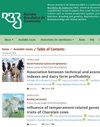Substitution of dry corn grain by rehydrated and ensiled corn grain, finely or coarsely ground, on performance of young bulls finished in feedlot
IF 1.2
4区 农林科学
Q3 Agricultural and Biological Sciences
Revista Brasileira De Zootecnia-Brazilian Journal of Animal Science
Pub Date : 2022-01-01
DOI:10.37496/rbz5120200160
引用次数: 1
Abstract
- We investigated the effects of corn grain, finely or coarsely ground, rehydrated and ensiled to 35% moisture in substitution of dry corn grain on performance of beef cattle in the feedlot. Forty non-castrated young Angus crossbred bulls with average age of 13±1.4 months and average initial body weight (BW) of 374±14 kg. The experiment was conducted in blocks by weight, and bulls were randomly assigned into four groups of five animals each in a 2 × 2 factorial scheme. The factors evaluated were particle size (finely and coarsely ground) and two grain sources (dry ground corn and rehydrated corn grain silage). The treatments were diets containing dry corn grain, finely ground (DCF; 1.86 mm); dry corn grain, coarsely ground (DCC; 3.53 mm); rehydrated and ensiled corn grain, finely ground (RCF; 1.86 mm); and rehydrated and ensiled corn grain, coarsely ground (RCC; 3.53 mm). Initial BW, final BW, average daily gain (ADG), feed efficiency, and intake of dry matter (DMI), acid detergent fiber, and metabolizable energy were not affected by treatment. Ensiling corn grain decreased DMI by 10.3% (11.6 vs. 10.4 kg/d for dry and ensiled, respectively) and increased feed efficiency by 13.3% (0.13 vs. 0.15 kg/d for dry and ensiled, respectively), but there was no effect of particle size, grain source, and their interaction on ADG. Effects of particle size and grain source were observed for fecal starch and total tract starch digestion, with evidence that treatments containing rehydrated corn diets showed greater efficiency in the utilization of dietary starch. Animals fed RCF diets showed lower fecal starch losses of 37, 55, and 75% when compared with treatments RCC, DCF, and DCC, respectively. Our results suggested that ensiled rehydrated corn grain improves feed efficiency in substitution of dry corn grain. The finely and coarsely ground of rehydrated and ensiled corn grain increases the digestibility of starch for finishing cattle in feedlot . Substitution of dry corn grain by rehydrated and ensiled corn grain, finely or coarsely ground, on performance of young bulls finished in feedlot.用细碎或粗碎的复水化青贮玉米代替干玉米对育肥牛生产性能的影响
-在饲养场研究了细磨或粗磨玉米粒,再水化并青贮至35%水分,替代干玉米粒对肉牛生产性能的影响。未阉割的安格斯杂交公牛40头,平均年龄13±1.4个月,平均初始体重374±14 kg。试验按体重分组进行,公牛按2 × 2因子法随机分为4组,每组5头。评价的因素是粒度(细磨和粗磨)和两种谷物来源(干磨玉米和再水化玉米青贮)。各组饲粮分别为:玉米干粒、细粒(DCF);1.86毫米);干玉米粒,粗磨;3.53毫米);细碎的再水化青贮玉米粒(RCF);1.86毫米);再水化和青贮的粗磨玉米粒(RCC);3.53毫米)。初始体重、终体重、平均日增重(ADG)、饲料效率、干物质(DMI)采食量、酸性洗涤纤维和代谢能均不受处理影响。青贮玉米的DMI降低了10.3%(干、青贮分别为11.6和10.4 kg/d),饲料效率提高了13.3%(干、青贮分别为0.13和0.15 kg/d),但颗粒大小、籽粒来源及其互作对平均日增重没有影响。观察了颗粒大小和颗粒来源对粪便淀粉消化和全肠道淀粉消化的影响,有证据表明,添加复水化玉米饲粮的处理对饲粮淀粉的利用效率更高。与RCC、DCF和DCC处理相比,饲喂RCF的动物粪便淀粉损失分别降低了37%、55%和75%。综上所述,青贮水化玉米籽粒可以替代干玉米籽粒,提高饲料效率。复水化青贮玉米籽粒经细磨和粗磨后,可提高育肥牛对淀粉的消化率。用细碎或粗碎的复水化青贮玉米代替干玉米对育肥牛生产性能的影响。
本文章由计算机程序翻译,如有差异,请以英文原文为准。
求助全文
约1分钟内获得全文
求助全文
来源期刊
CiteScore
1.90
自引率
0.00%
发文量
25
审稿时长
8 weeks
期刊介绍:
The Revista Brasileira de Zootecnia (RBZ; Brazilian Journal of Animal Science) encompasses all fields of Animal Science Research. The RBZ publishes original scientific articles in the areas of Aquaculture, Biometeorology and Animal Welfare, Forage Crops and Grasslands, Animal and Forage Plants Breeding and Genetics, Animal Reproduction, Ruminant and Non-Ruminant Nutrition, and Animal Production Systems and Agribusiness.

 求助内容:
求助内容: 应助结果提醒方式:
应助结果提醒方式:


